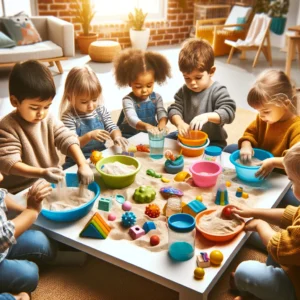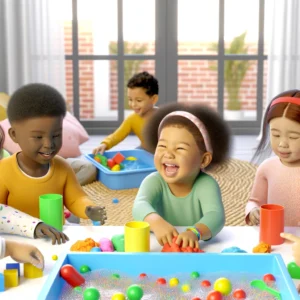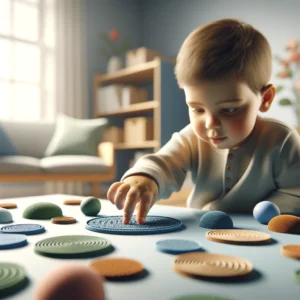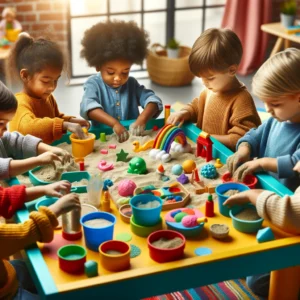In the bustling and ever-evolving landscape of child development, sensory play emerges as a cornerstone in nurturing young minds. At AppleBee Kids, we believe in embracing comprehensive approaches to early education, where sensory experiences play a pivotal role.
What is Sensory Play?
Sensory play involves activities that stimulate a child’s senses: touch, smell, taste, sight, and hearing. These activities are designed to naturally encourage children to use scientific processes while they play, create, investigate, and explore. The increasing acknowledgment of sensory play’s benefits underscores its importance in developmental curriculums.
The Science Behind Sensory Play
Sensory play is a critical element of early childhood development, supported by an extensive body of research underscoring its pivotal role in building neural connections that form the architecture of the young brain. This form of play involves any activity that stimulates a child’s senses of touch, smell, taste, sight, and hearing, fostering growth in myriad ways that are both fundamental and profound.
At its core, sensory play is grounded in experiential learning, where children learn through experience and discovery. This type of play engages the neural pathways that are essential for all forms of learning. When children interact with materials that vary in texture, colour, smell, and sound, they are doing much more than just exploring these materials—they are building the foundation for complex learning tasks that they will encounter throughout their lives.
Neurological Development
The brain’s development is phenomenally rapid in the early years, with over 90% of brain growth occurring by the age of five. During sensory play, children’s brains are actively forming connections between nerve cells, driven by sensory input. These connections, or synapses, are created at a staggering rate and are pruned and strengthened through experiences. Sensory play acts as a catalyst for the synaptogenesis process, where repeated sensory experiences reinforce these synapses. It is through these reinforced pathways that permanent learning takes place.
Sensory Integration
Sensory integration is the process by which the brain organises and interprets external stimuli such as sights, sounds, textures, and smells. Effective sensory integration is crucial for children to perform complex tasks, from reading and writing to more dynamic activities like playing sports or creating art. Sensory play naturally helps children develop sensory integration skills by exposing them to a variety of sensory experiences in a structured yet natural environment. This not only helps children learn to process sensory data more efficiently but also aids in regulating their responses to varying sensory inputs, which is particularly beneficial for children with sensory processing disorders.
Cognitive and Emotional Growth
Sensory play directly influences cognitive development, including memory, thought, recognition, and understanding. For instance, when a child manipulates objects, they learn cause and effect (“What happens when I do this?”), spatial relationships (“Where is this?”), and problem-solving skills (“How can I make this work?”). These experiences are critical as they lay the groundwork for abstract thinking, allowing children to use information in new ways.
Emotionally, sensory play offers children an intrinsic comfort, particularly as they manipulate natural elements like sand or water. It can be incredibly soothing and offers a therapeutic quality, providing a sense of calm for children who may experience anxiety or stress. Furthermore, this form of play supports emotional development by giving children a way to express their feelings through their creations and interactions with materials.

Enhancing Learning Through Sensory Play
To maximise the benefits of sensory play, it is important for caregivers and educators to provide diverse and engaging sensory experiences. These can range from simple activities like playing with dough to more elaborate setups involving sensory tables or themed sensory bins. Each experience can be tailored to meet educational objectives or adapted to suit individual developmental levels.
Moreover, sensory play should be a regular feature in the curriculum to ensure that children are continuously exposed to new and challenging sensory experiences. As they grow and develop, the complexity of these activities can be increased to match their advancing skills.
The science behind sensory play is compelling. It is not merely about providing fun activities for children but about nurturing an environment that moulds their developing brains. Engaging the senses is not just a way to expand the mind—it is a crucial strategy for holistic development, setting children up for success in both academic and life skills. This understanding should drive our approach to early childhood education, emphasising the need for sensory-rich environments that support robust brain development and a solid foundation for lifelong learning.
Cognitive Benefits of Sensory Play
- Enhances Memory – Sensory play helps cement learning by anchoring information through sensory interaction.
- Boosts Problem Solving Skills – Activities like building blocks or figuring out how to move sand through a sieve encourage strategic thinking and resilience.
- Promotes Language Development – Describing their sensory experiences helps children build vocabulary and improve their language skills.

Social Benefits of Sensory Play
- Fosters Cooperation and Sharing – Group sensory activities require children to work cooperatively, share tools, and respect each other’s space and ideas.
- Encourages Empathy – By engaging in play that involves turn-taking and negotiation, children learn to understand and respond to their peers’ feelings.
Implementing Sensory Play in Everyday Learning
Parents and educators can incorporate sensory play into daily activities with ease. Here are some practical tips:
- Use Household Items: Simple setups using rice, pasta, beans, or water can be effective.
- Create Themed Bins: Themed sensory bins, such as a beach bin with sand and shells, can ignite imagination and learning.
- Emphasize Natural Elements: Incorporating items like leaves, rocks, and twigs can connect children with nature while stimulating their senses.
Sensory Play and Special Needs
Sensory play is particularly impactful for children with special needs. It can be therapeutic and can be tailored to meet individual needs, providing a unique approach to learning that traditional methods may not offer.


Challenges and Considerations
While sensory play is beneficial, it requires careful planning to ensure safety and appropriateness. All materials used should be non-toxic and suited to the child’s developmental stage to prevent choking hazards or other risks.
The role of sensory play in cognitive and social development is undeniable. It is a joyous, engaging, and profoundly educational journey that every child deserves to experience. At AppleBee Kids, we champion these playful learning experiences, recognizing their power to shape skilled, social, and happy learners.
